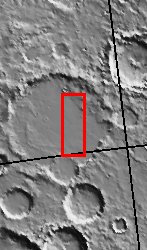
This image is from a region called Terra Sirenum in Mars' southern hemisphere. This region was named in 1958 for the Sea of the Sirens from Greek Mythology. This is not a sea, however, but a relatively dusty, high albedo region of Mars. There are numerous dust devil tracks that are apparent in the center- left of the image. The dust devils act like vacuum cleaners and lift dust off of the surface leaving a less dusty and relatively lower albedo surface behind. Dust devils are very common on Mars and are thought to be the primary mechanism for constantly lifting the dust into the atmosphere. Dust is constantly present in the Martian atmosphere in greater abundances than typically seen on Earth. The Martian dust is one of the main factors that affect the present Martian climate and clearly displays the relationship between Mars' geology and atmosphere.
Note: this THEMIS visual image has not been radiometrically nor geometrically calibrated for this preliminary release. An empirical correction has been performed to remove instrumental effects. A linear shift has been applied in the cross-track and down-track direction to approximate spacecraft and planetary motion. Fully calibrated and geometrically projected images will be released through the Planetary Data System in accordance with Project policies at a later time.
NASA's Jet Propulsion Laboratory manages the 2001 Mars Odyssey mission for NASA's Office of Space Science, Washington, D.C. The Thermal Emission Imaging System (THEMIS) was developed by Arizona State University, Tempe, in collaboration with Raytheon Santa Barbara Remote Sensing. The THEMIS investigation is led by Dr. Philip Christensen at Arizona State University. Lockheed Martin Astronautics, Denver, is the prime contractor for the Odyssey project, and developed and built the orbiter. Mission operations are conducted jointly from Lockheed Martin and from JPL, a division of the California Institute of Technology in Pasadena.

